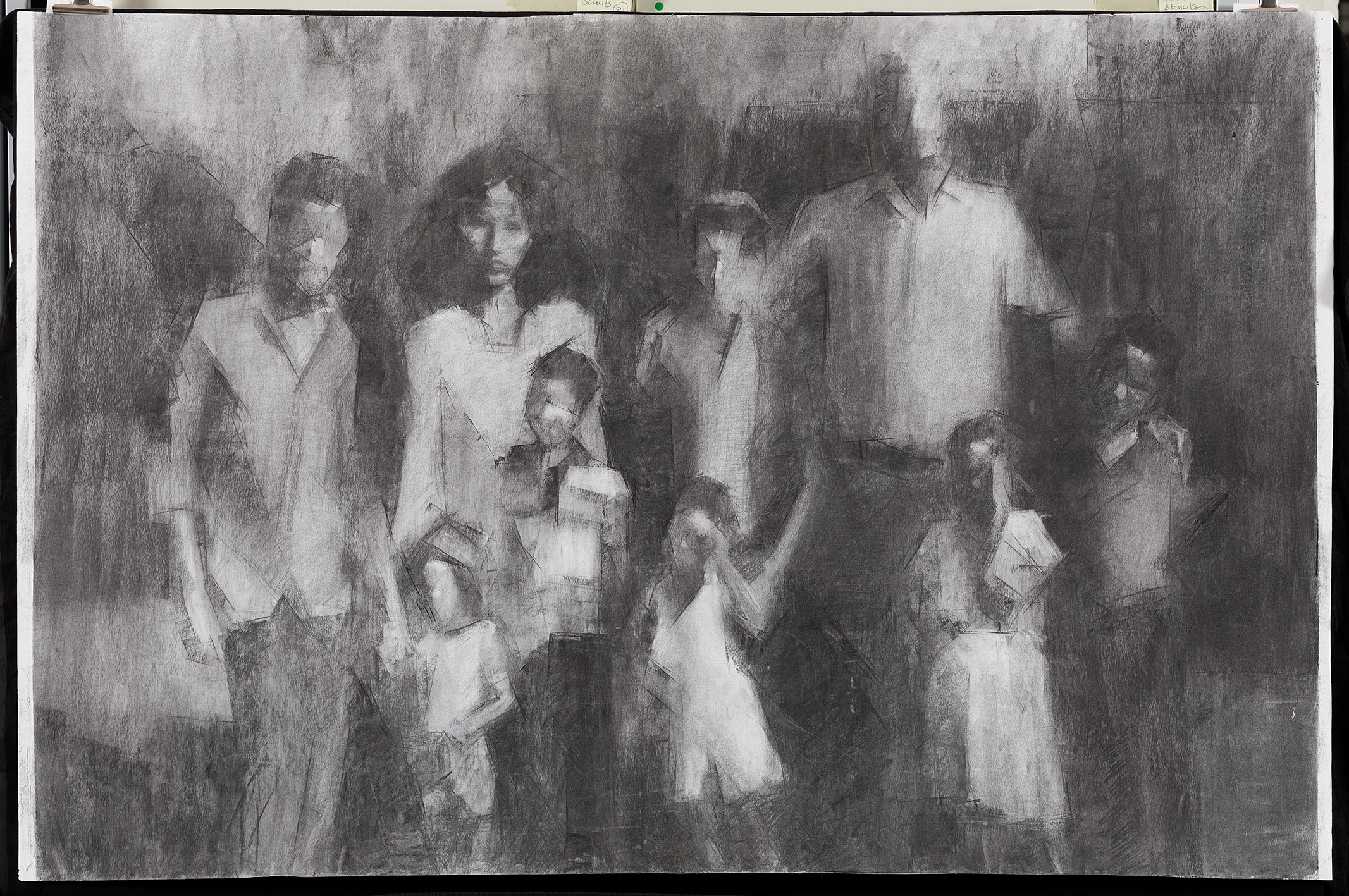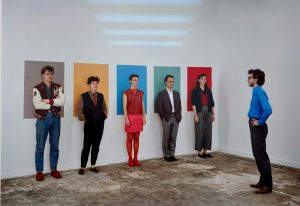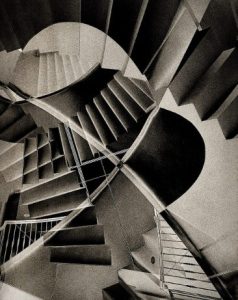English follows Hebrew
מלבד תחושה של חוסר הקפדה על אופן העמדה אין מכנה משותף לתערוכות של מלך ברגר וטגיסט יוסף רון . בשני המקרים מדובר בתערוכות שנכון היה להציג ולשתיהן נלוות תחושת החמצה .
בתערוכה של יוסף רון “הנייר הלבן שחור מבפנים” מספר רב של רישומים מצוינים ומצער שבחלק ניכר מהם לא ניתן, משום זווית באולם, לצפות כשורה. ההשתקפויות בזכוכית מונעות זאת. שימוש בזכוכית אנטי רפלקטיבית (זכוכית מוזאלית) היה פותר, לפחות במידה רבה, את הבעיה. ההערה אולי נשמעת נוקדנית אבל במיוחד כעת, בזמן של בחינת האיכות של אמנות כחוויה בלתי אמצעית מול התבוננות בדימוי מתווך במדיה, בעיקר דיגיטלית, יש לכך חשיבות רבה. חלק ניכר מהדימויים בתערוכה של יוסף רון נעלמים בצפייה ישירה וחבל.
“עתלית” דימוי דיוקן קבוצתי, העבודה הגדולה בתערוכה, מצוינת. יוסף רון הופכת את הדיוקן הקבוצתי, דימוי שכיח כל כך עד שנהפך לקלישאה , להתרחשות מרתקת בה דיוק, טשטוש, גנרי וספציפי ,יוצרים רגע שנחרט בזיכרון . שלושה מבוגרים וששה ילדים, ספק משפחה, מביטים קדימה בלי עיניים, אולי מסונוורים משמש מסמאת. כוחה של העבודה במרחב שהיא מסמנת בין הדמויות המצוירות לצופים בהן : הפנים נמסים כזיכרון מעורפל, אבל קוויהם זוויתיים כמו חצובים מאבן. ראש ילד שיד מגוננת המונחת אליו מזכירה גג משולש, אולי של בית, וזרועות דמות גבר גבוה החובק שני ילדים פרושות לצד כמו זרועות מריה של הרחמים (Madonna della Misericordia), שמתחתן חוסים נרדפים או נצרכים. הקבוצה הזו, השקטה, עומדת במקום לא מובחן, לא בוטחת אך חזקה, ונדמה כאילו יכולנו, לו פגשנו בהם, להכיר אותם.

בתערוכה כך נכתב בטקסט הנלווה , העבודות הן הדיוקנאות ורשמים ממרכז הקליטה בעתלית, שם התגוררה משפחתה לאחר שהגיעו לארץ ב”מבצע משה” בו הגיעו חלקים נרחבים מהקהילה היהודית באתיופיה ב־1984. שם התערוכה, כשם עבודה של משה גרשוני מ 1970 הוא אמנם משחק לשוני חביב, אידיוסינקרטי למדי הפונה למעגל הפנימי של שוחרי האמנות הישראלים , אך הבחירה בו מנציחה את נקודת המבט ההגמונית: הקריאה של התבוננות אמנית ממוצא אתיופי על ההיסטוריה, הלא רחוקה, מוכתרת בכותרת מתוך מה שכבר משויך לקאנון הישראלי.

“מלך ברגר: התנאי לשגשוג האנושות” היא תערוכה הנפרשת על פני כמה וכמה אולמות. הריבוי מחליש אותה ויוצר תחושה כאילו הוצבה כידי למלא חלל ריק או שהאוצרות נמנעו מתהליך של בחירת העבודות ותלו מה שנמצא במחסני האמן שפעל עד כה מחוץ לזרם המרכזי, או לפחות מה שהיה שם משנות ה 80, העשור שרובן המוחלט של העבודות נעשו בו.
העשייה של ברג , המצוי כעת בשנות ה 90 לחייו ומציג , כך נכתב לראשונה , מסקרנת ואי-אפשר שלא לתהות מה יצר לפני ואחרי שנות ה 80 , היכן הוצגו ונשמרו העבודות המוצגות ולמי היו מוכרות .

בשנות ה 80 יצר ברגר במסורת הריאליזם הסוציאליסטי בגרסתו האירופאית והלטינו אמריקאית (בעיקר ציורי הקיר של דייגו ריברה , חוזה קלמנטה אורזוקו , ודוד אלפרו סיקוורס), זרמים שכבר היו באותן השנים, במידה רבה, נחלת העבר. העבודות הן מחומרים מהטבע – גרעינים, זרעים, זרדים, נוצות, קליפות עצי תמר, חלוקי אבן קטנים, אך את הדבקתם על משטחים עשה עם דבק פלסטי, פולימר סינטטי . השקפת העולם העולה מהעבודות היא זו של קומוניזם תמים, אמונה באפשרות של שלום עולמי, אחווה ושוויון.
האופוס מגנום של ברגר, “התנאי לשגשוג האנושות” – היא עבודה המורכבת מ-36 חלקים וכוללת קונבנציות חזותיות משמש עולה , יוני שלום לבנות ועד דמויות גבר ואישה צעירים פניהם צופים לעתיד .קטעי טקסט בעברית, ערבית אנגלית ורוסית מדברים על טובת האנושות וחלליות מוצבות ליד ספר פתוח . למרות שהעבודה העצומה הזו מזכירה ויוצרת שלל אסוציאציות לאמנות פוליטית מרחבי העולם, בעיקר במחצית המאה הקודמת הרי שיש לה גם אפיונים פרטיקולריים מעניינים החל מההצבה של דמויות האנוש הגדולות במה שנראה כקווי מתאר של גלגל שיניים (שנראה גם כפה מפלצתי טורף עם שינים מחודדות) ודרך הייצוג של מה שנראה ככרטיסיית ניקוב punch card של מחשבים ששימשו לשמירת מידע באותן שנים . הנושאים, המסרים , עצם הגודל ובחירת החומרים מצדיקים את ההצגה ואת ההתבוננות.
תערוכה קטנה בהרבה, עם עבודה זו ועוד עבודות אחדות כמו “הקץ למלחמות” 1985 או “החלום הבדואי להיות חקלאי” 1980 הייתה בבחינת הערה והארה לקריאה התרבותית הרחבה של האמנות הישראלית של אותן שנים.
טגיסט יוסף רון:זוכת הפרס ע”ש חיים שיף לאמנות פיגורטיבית-ריאליסטית לשנת 2019
אוצרת: עמנואלה קלו
מלך ברגר: התנאי לשגשוג האנושות
אוצרת: רותי דירקטור. ע. אוצרת: גלית לנדאו־אפשטיין
מוזיאון תל אביב לאמנות
רון מיואיק
האקדמיה של החלון – הרצאות ד”ר סמדר שפי ב ZOOM
יום ב, 1 מרץ, ב 20:00
לינק לרישום ותשלום
https://forms.gle/gMc8tFz4MnQuWKaH9
רון מיואיק Ron Mueck יוצר פסלים היפר ריאליסטים מרתקים ומצמיתים שגורמים להתבוננות מחודשת, מחודדת, קשובה במה שנדמה לנו כמוכר, מה שאנו מגדירים כאנושי. בעבודותיו הוא משחק עם קנה מידה מהגדלה לממדי ענק ועד מיניאטורות כשהוא חוקר רגשות ואת אופן הבעתם. אחרי קריירה כבובנאי האמן האוסטרלי -אנגלי שמעולם לא למד אמנות , פרץ לתודעה ב 1997 בתערוכה SENSATION , התערוכה הראשונה בה הציג איפעם. מאז הציג במוזאונים ואירועי האמנות המובילים בעולם. בפרספקטיבה שח עבודתו נדבר על יחסי בובות/פיסול זר/מוכר.


Some thoughts on the exhibitions by Tigist Yoseph Ron and by Melech Berger at the Tel Aviv Museum of Art
Posted on February 24, 2021 by Smadar Sheffi
Other than less than stringent standards in the curatorial work on the two solo exhibitions, there is no common denominator to Melech Berger’s and Tigist Yoseph Ron’s shows. Both are worthy of exhibiting, yet the exhibitions leave much to be desired.
Yoseph Ron’s “The White Paper is Black Within” is comprised of many excellent drawings, yet it is distressing that the majority of the pieces cannot be viewed properly due to reflections, which do not disappear at any angle of observation. Framing with anti-reflective museum quality glass would have solved the problem. Perhaps this resonates as pedantic, but especially today, when we are re-experiencing art unmediated by digital media, this is particularly important.
The group portrait Atlit is the largest piece in the exhibition, and an excellent one. Yoseph Ron transforms the group portrait, an image so familiar as to have become a cliché, into a fascinating event in which generic and specific precision and blurring create a moment engraved in memory. Three adults and six children, which may or may not be one family, stare forward without their eyes being visible, perhaps blinded by the sun. The power of the artwork lies in the space that it generates between the drawn figures and the viewers. Faces seem to melt as if in a misty memory, but their angular lines seem to be hewn in stone. The head of a boy covered with a protective hand on him is reminiscent of a peaked roof, perhaps of a house, while a tall man’s arms embracing two children are held like the Madonna della Misericordia, whose outstretched arms shelter the persecuted or needy. This quiet group is standing in an undifferentiated location, standing wary but strong, and it seems that if we were to meet them, we would be able to recognize them.

The text informs us that the portraits and sketches are from the Atlit Absorption Center where the artist’s family resided after arriving in Israel in Operation Moses in which a large part of the Ethiopian Jewish community were covertly evacuated to Israel in 1984. The title of the exhibition, taken from Moshe Gershuni’s artwork of 1970, is a play on words, but too idiosyncratic as it is understandable only by a small circle of cognoscenti of Israeli art. The choice of this title perpetuates the hegemonic point of view, reading the reference by an artist of Ethiopian origin of the not-too-distant history of Israel art, with a title taken from the Israeli art canon.

Melech Berger: Conditions for a Flourishing Humanity is installed in several halls. The large number of works weakens the exhibition as it seems that it is merely filling the empty space, or that the curators avoided selecting works, and hung what was in the artist’s storeroom made over decades as someone outside the mainstream, or at least out of the mainstream of the 1980s when most of the works on view were made.

The art by Berger, now in his 90s and showing for the first time, is interesting, and one can’t help but wonder what he made before and after the 1980s, where they were stored, and who knew about them.
Berger’s oeuvre of the ‘80s is in the tradition of the European and Latin American version of Social Realism (especially the murals by Diego Rivera, Jose Clemente Orozco and David Alfaro Siqueiros0), which was already much less popular in that decade. He uses natural materials – seeds, grains, branches, feathers, palm tree peelings, small pebbles – but glues them to surfaces with plastic glue, a synthetic polymer. A naïve communism arises from his works, a belief in world peace, brotherhood, and equality.
Berger’s magnum opus, Conditions for a Flourishing Humanity (1984), comprised of 36 parts, includes visual conventions such as a rising sun, doves of peace, and additional images of a young man and woman facing the future. He includes texts in Hebrew, Arabic, English, and Russian on the benefit for humanity, with spaceships placed adjacent to an open book. Although this huge work is reminiscent of and creates many associations to political art from the world over, especially from the last half of the 20th century, it also contains interesting particular features, from the placement of the large human figures in what look like contours of large gear wheels (looking like a monstrous devouring mouth, with its sharp teeth) through to the representation of what looks like a punch card formerly used for information storage. The topics, messages, size, and materials justify the exhibition and a close look.
A much smaller exhibition with this and another few works such as the 1985 A Farewell to Wars, or The Bedouin Dream of Being a Farmer (1980) could have been a kind of comment and insight towards a broader cultural reading of Israeli art of that period.
Tigist Yoseph Ron: Recipient of the Haim Shiff Prize for Figurative-Realistic Art, 2019: The White Paper is Black Within
Curator: Emanuela Calò
Melech Berger: Conditions for a Flourishing Humanity
Curator: Ruth Direktor
Assistant Curator: Galit Landau Epstein






